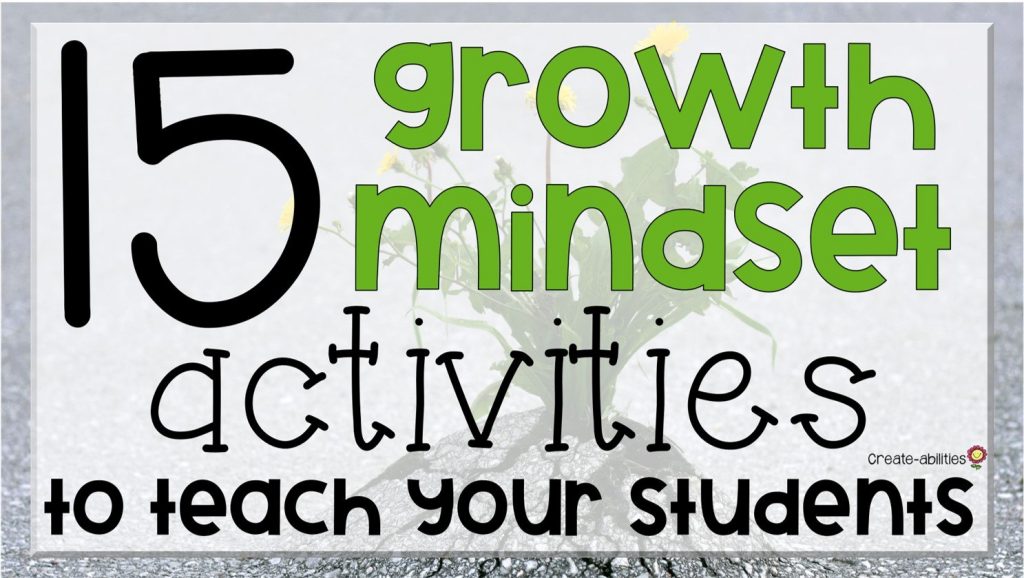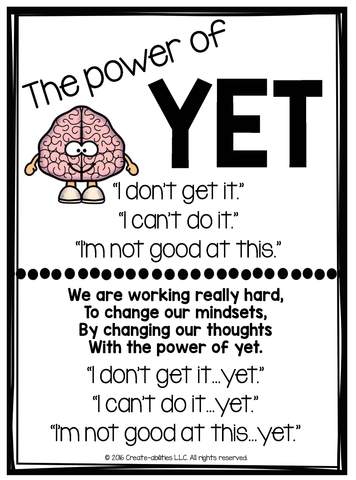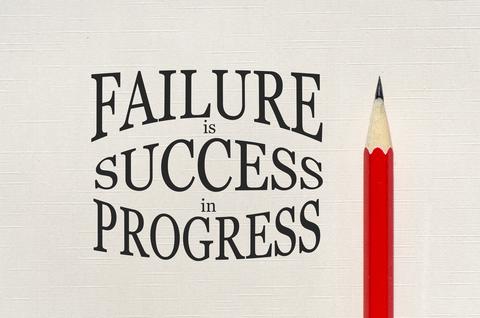
15 Growth Mindset Strategies to Teach Your Students
If you’re like me, when you read about having a growth mindset, you read about the idea of giving our students strategies to use when approaching a problem.

Rather than parroting some true but ultimately abstract ideas on growth mindset, I wanted to give teachers something real, tangible, and actionable that they can implement in their classrooms. So here are some classroom best practices that I’ve found and created to help your students develop a growth mindset. Let’s dive in.
1. TEACH ABOUT FIXED MINDSET VS. GROWTH MINDSET
Recent develops in neuroscience have taught us that our brain is very malleable- more so than we ever though before. “Research on brain plasticity has shown how connectivity between neurons can change with experience. With practice, neural networks grow new connections, strengthen existing ones, and build insulation that speeds transmission of impulses. These neuroscientific discoveries have shown us that we can increase our neural growth by the actions we take, such as using good strategies, asking questions, practicing, and following good nutrition and sleep habits.” (Mindset Works, 2017)
This means that knowledge isn’t fixed! When we have a fixed mindset, we believe that people aren’t capable of learning things that they don’t take naturally to. We believe that some students are good at math, while others are good at reading. This couldn’t be further from the truth. When we have a growth mindset, we understand that with the right kind of effort, we can learn anything. Learning is a process; a pathway to understanding. The path I may need to take to learn things may be different from the path you may need to take to learn things. That may give me a learning advantage in some areas, and you a learning advantage in others. But in the end, there is a pathway to the same level of understanding for both of us, no matter what the concept is. Having a growth mindset is about knowing that, and finding that path to understanding.
2. CREATE A SAFE PLACE FOR RISK TAKING
Parts of working toward a solid understanding of a concept are taking risks, trying new things, and overcoming obstacles. Let your students know that you value trying new things, thinking outside the box, trying over and over again, and facing a challenge head-on. That will help your students feel safe enough to take a learning risk themselves.
This can be accomplished by using number talks during math, trying a new strategy when solving a word problem, or making an effort to decode a word during guided reading. Celebrate and encourage these efforts daily and your students will feel validated in their risk-taking.
3. SET ACHIEVABLE MICRO-GOALS
Encourage growth and progress by setting small goals for your students. This will help build their confidence and help develop a growth mindset.
This could mean writing their name daily on their paper, getting 5 spelling words right, passing a level on their fact fluency test, and more. Any small goal along the pathway to understanding can encourage and bolster your students. Focus on the process they took to reach the goal, what they could learn from and do better next time, and how good it felt to accomplish something that felt difficult.
4. PRAISE PROPERLY
Make sure to praise the learning process (not just effort). Say things such as “I’m proud of you for trying more than one strategy when trying to solve that math problem!” or “The point isn’t to get it right away. The point is to grow your understanding step by step. I like how you didn’t give up when things got hard.”
Some ideas of phrases to use are below.

5. EMBRACE THE WORD YET
As Dweck herself put it in a TED talk, “Just the words ‘yet’ or ‘not yet,’ we’re finding, give kids greater confidence, give them a path into the future that creates greater persistence.”
If a student says, “I can’t spell my words correctly.”, you can change their mindset by saying “You can’t spell your words correctly….YET.” Some things take time, effort, and practice and that’s okay. It’s expected. With persistence, practice, and asking for help, students can learn what they think they aren’t good at.

6. TAKE ADVANTAGE OF MISTAKES
“Making mistakes and accepting failure are natural and important parts of the learning process. Adopting a growth mindset in the face of failure provides both short- and long-term benefits; it turns mistakes into challenges for triumph — just speed bumps along the way to learning and mastery. When children make a mistake, Dweck explains, parents and teachers should be ready to praise them for their efforts, but not their efforts alone. They should also be sure to point out new ways of approaching a given problem, ones that point out the flaws or shortcomings of a previous strategy.
Of course making mistakes and failing is tough to manage, both for parents and children — but if you really want to help your kid develop a growth mindset, you need to help normalize mistakes and failures. You should use these potentially painful experiences as springboards for learning and progress.” (Noodle.com, 2015)
7. ESTABLISH HIGH EXPECTATIONS
Have you ever heard of the self-fulfilling prophecy? If you set the bar high and offer the right support to your students, they will rise to meet the challenge. If your students know you expect a lot of them, they will begin to expect a lot of themselves.
This could mean setting a goal to learn all of their math facts 0-10 by the end of the year, or moving up 2 reading levels. Anything that will push your students to try hard and want to succeed.
8. TALK ABOUT YOUR OWN MINDSET
Our students can learn from our experiences and examples. Talk openly about your struggles, your mistakes, and your mindset. This also helps create a safe zone for students to share their thoughts and feelings.
This could mean talking about how you felt you weren’t good at math growing up or how your dyslexia made it hard to read and complete your homework. Talking openly about your own mindset can be powerful for the kids in our room because they begin to feel like they aren’t alone and that it’s okay to struggle.
9. GIVE OUR STUDENTS OPTIONS TO ASK FOR HELP WHEN NEEDED
“Eventually we all reach a point where we cannot figure out a solution. This can be a good time to ask for help. People with a growth mindset are more concerned about growing knowledge and skills than trying to look smart by not asking questions. Teachers we work with often model the process of asking for help from their students in classrooms, for example, and are open to asking for ideas from colleagues for making lessons more effective while sharing ideas.” (Teachthought.com, 2017)
Teach your kids that asking for help is a valuable tool that they always have in their learning toolbox. In fact, some of the smartest, most accomplished people in the world never stop asking questions to seek for understanding. Asking for help isn’t something to be ashamed or embarrassed about. It’s a valuable step toward learning and understanding.
This could mean having a “student teacher” in your room for different assignments that other kids can go to for help. It can mean setting the right tone so they feel comfortable coming to you for help.
10. EXPLAIN THAT SOME THINGS TAKE TIME AND EFFORT
Learning something new can sometimes take hard work, time, and effort. Some students think that if something is hard, they aren’t smart enough to do it. Those students are the ones that often give up. Teach your kids that it’s okay that something is hard and that effort is a skill.
This can mean working on a project for several weeks. It could also be practicing math facts all year long until they are mastered.
11. DEVELOP STAMINA
Learning can be challenging and it can take time. Sometimes when something seems difficult and is taking a long time, we want to give up. If we can develop our stamina, we can finish the task at hand. This can be done by working on a project for only a few minutes at a time. Then, day by day, increase the amount of work time until you get to your target amount. This will help you students build their stamina when approaching a project.
This could mean reading silently for 1 minute a day. Then 2 minutes, then 3, and so on until your students can read independently for 15-20 minutes.
12. TEACH THE VALUE OF CHALLENGES
When we push through the limits of our comfort zone to achieve a goal or accomplish something challenging, our brain forms stronger connections and our intelligence improves over time. Something that is challenging not only helps us learn or use new strategies (because we need to try something that we’ve never done before to solve the problem), it also gives us confidence to continue approaching things that may seem difficult.
One effective way I found to embrace a challenge, was to do a weekly open-ended math task in my room. Students could approach a math problem in their own way, using a variety of strategies. It helped build confidence and solidify the process over the product. You can learn more by clicking on one of the links below.
1. Math Task Explanations Part 1
2. Math Task Explanations Part 2
3. Math Task Explanations Part 3
4. Math Task Webinar (Free Online PD)
13. USE GOAL-BASED JOURNALING
Let your students write down their goals, what they plan to do to reach them, and how they are progressing toward their end goal. This will help them realize that their traits, knowledge, and skills are fixed. Remember that goals should be “SMART”:
Specific
Measureable
Attainable
Realistic
Time-based (a set time like 1 week or 1 month, not vague)
14. USE SUCCESS FOLDERS
Sometimes it’s easy to get bogged down in our failures and frustrations. Help alleviate this by using Success Folders. Give each student a regular folder (the kind with two pockets or brackets) and let them personalize them. Then, set aside a time each week for students to right down or include examples of successful learning in their folder. This could mean including a test they passed, writing a paragraph about a goal they met, an explanation of a new concept they learned, or a phrase they said to themselves to help their growth mindset. This is a powerful reminder of the positive steps each student has taken.

15. LET KIDS FAIL
This sounds harsh, and is often hard to do as caring educators, but letting a student fail at something can be a powerful learning tool. Jessica Lahey, author of The Gift of Failure, talks about how letting kids fail helps the process of trial and error. It helps them make discoveries about themselves and the world around them. It also helps them learn lessons on responsibility, stamina, grit, follow-through, and more. This will foster a sense of accomplishment when they do complete a task and will teach them persistence.
“Failure is simply the opportunity to begin again, this time more intelligently.”
-Henry Ford
PEACE, LOVE, AND STICKY NOTES
Blog Categories
Meet the author



